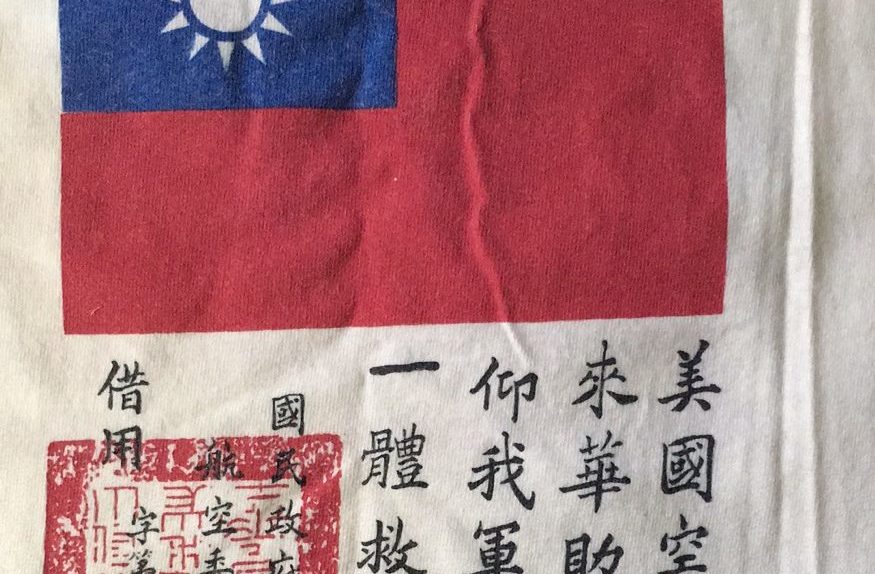

Fuzzy memory: when I was a kid, my mom wore a shirt memorializing the Flying Tigers, a volunteer U.S. reserve pilot group that symbolized a historical high point in the U.S. – Republic of China (ROC) alliance.
Turns out the memory was real – my mom found the shirt and sent me photos of it (see above). The shirt images are stylized versions of the “blood chits” carried by Flying Tigers in case they were shot down over ROC territory.
After the Allied victory, U.S.-ROC relations rolled unsteadily downhill. Following Japan’s surrender in 1945, General Marshall initiated what was supposed to be Asia’s version of the Marshall Plan, but this abortive attempt went nowhere. Without the military and economic support promised by the U.S., the ROC’s war-weary forces were defeated in 1949 by Mao’s Chinese Communist Party (CCP) and retreated to Taiwan. The USA’s postwar abandonment of the ROC, its closest ally in the Pacific theater, was the first of a series of betrayals that led to the ROC’s emasculation and the current shitshow featuring the U.S. and the People’s Republic of China (PRC).
For several decades after 1949, U.S. administrations maintained ostensible support for the ROC. In 1954, the two nations signed the Sino-American Mutual Defense Treaty, which guaranteed the safety of the ROC in the event of a CCP invasion. In 1971, however, Secretary of State Kissinger secretly visited the PRC and promised the CCP an opportunity to join the global family. Without U.S. support, the ROC (which I’ll now refer to as Taiwan) quickly lost its spot in the United Nations and has since struggled mightily to cling to any remnant of international recognition. Kissinger’s illicit visit was followed by Nixon’s historic trip in 1972, and in 1979 the USA formally tore up the 1954 treaty and established diplomatic relations with the PRC, finalizing the sell-out of its greatest Pacific ally.
Since the Kissinger/Nixon era, the USA has continued its complicity in the PRC’s marginalization of Taiwan. A few short years after the Tiananmen massacre in 1989, the Clinton administration began increased economic engagement with the CCP, on the absurd (only in hindsight, some argue) assumption that economic development would bring democracy to China. Successive administrations continued this magical thinking, and now here we are, on the brink of a new cold war.
Despite these setbacks, Taiwan has continued to blaze its own trail. It is now recognized as one of the world’s most progressive and participatory democracies, and it has been hailed for its exceptional handling of the coronavirus crisis. However, a direct result of its exclusion from the world stage is the hobbling of Taiwan’s ability to share data and contribute to the worldwide fight against COVID-19. Ironically, in our time of greatest need for COVID-19 guidance, one of the USA’s best sources of assistance is hog-tied by the world order arising from our own pro-PRC policies. How far we have fallen since the heroic days of the Flying Tigers.
I’ve linked a number of resources above in the text. For further information about this topic, I recommend these more in-depth sources:
- Wings Over China (documentary about the Flying Tigers)
- The China Mission: George Marshall’s Unfinished War, 1945-1947 by Daniel Kurtz-Phelan (book)
- The U.S. & Free China: How the U.S. Sold Out Its Ally by James Shen (personal account by the last Ambassador of the ROC to the U.S.)

you are back!! thanks for sharing this.
thanks for reading! are you still getting feedburner alerts? this post was more timely than I could have anticipated. a few days after, the USA and Taiwan held the highest-level official meeting since 1979.